Digital Innovation 11 Report: VR and AR Technologies in Education
VerifiedAdded on 2020/03/01
|11
|2464
|294
Report
AI Summary
This report, titled "Digital Innovation 11," examines the feasibility and value of Virtual Reality (VR) and Augmented Reality (AR) technologies within the education sector. It begins with an executive summary and table of contents, followed by an introduction that differentiates between VR and AR. The report then presents a business model canvas applicable to both technologies, outlining key partners, activities, value propositions, customer segments, and cost/revenue structures. The core of the report explores VR and AR applications in education, highlighting their capabilities and historical context. Customer segments, including students, tutors, and academic institutions, are identified. The report includes a customer journey analysis and concludes with a recommendation favoring AR due to its higher engagement factor and realistic approach. References are provided for further reading.
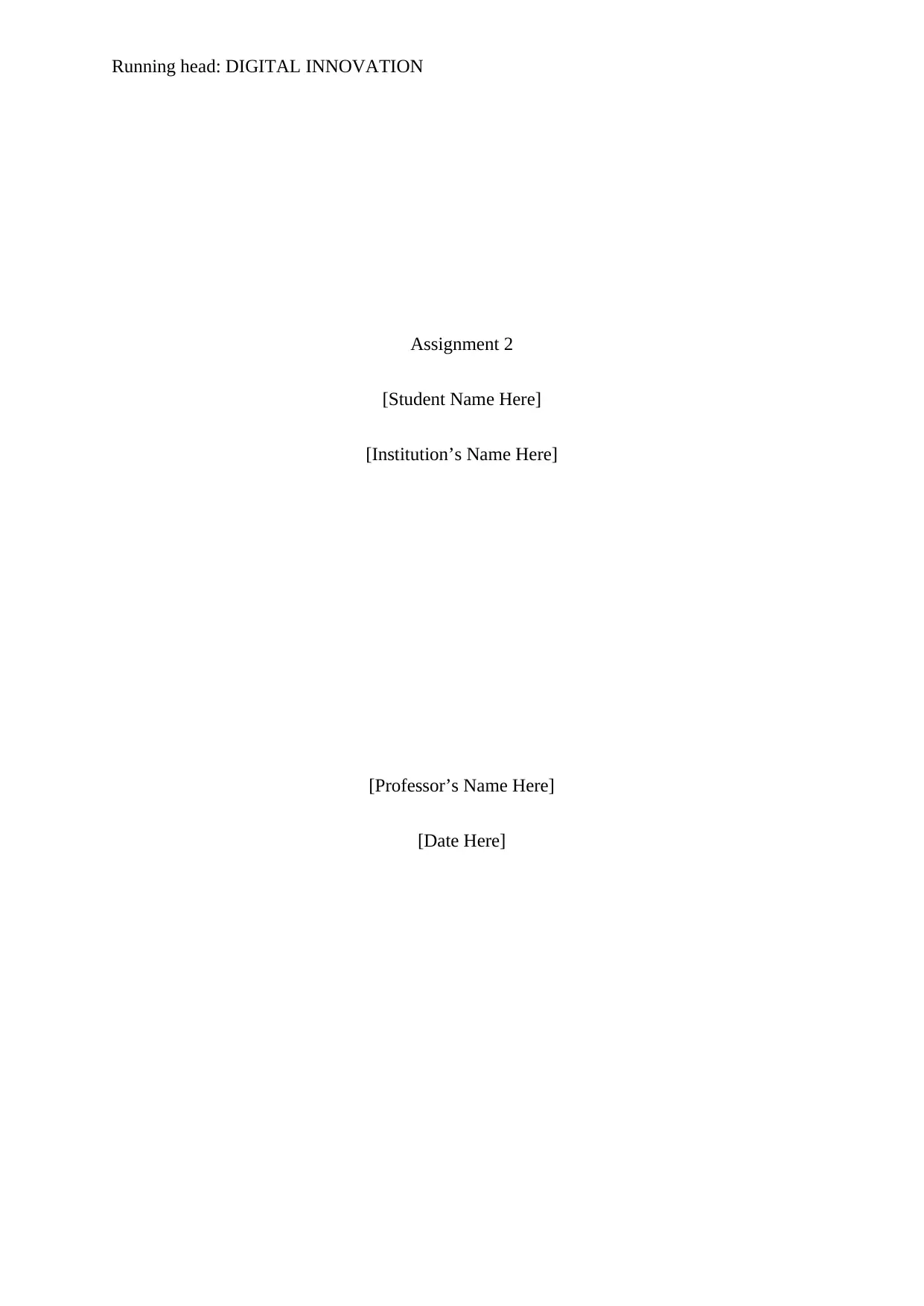
Running head: DIGITAL INNOVATION
Assignment 2
[Student Name Here]
[Institution’s Name Here]
[Professor’s Name Here]
[Date Here]
Assignment 2
[Student Name Here]
[Institution’s Name Here]
[Professor’s Name Here]
[Date Here]
Paraphrase This Document
Need a fresh take? Get an instant paraphrase of this document with our AI Paraphraser
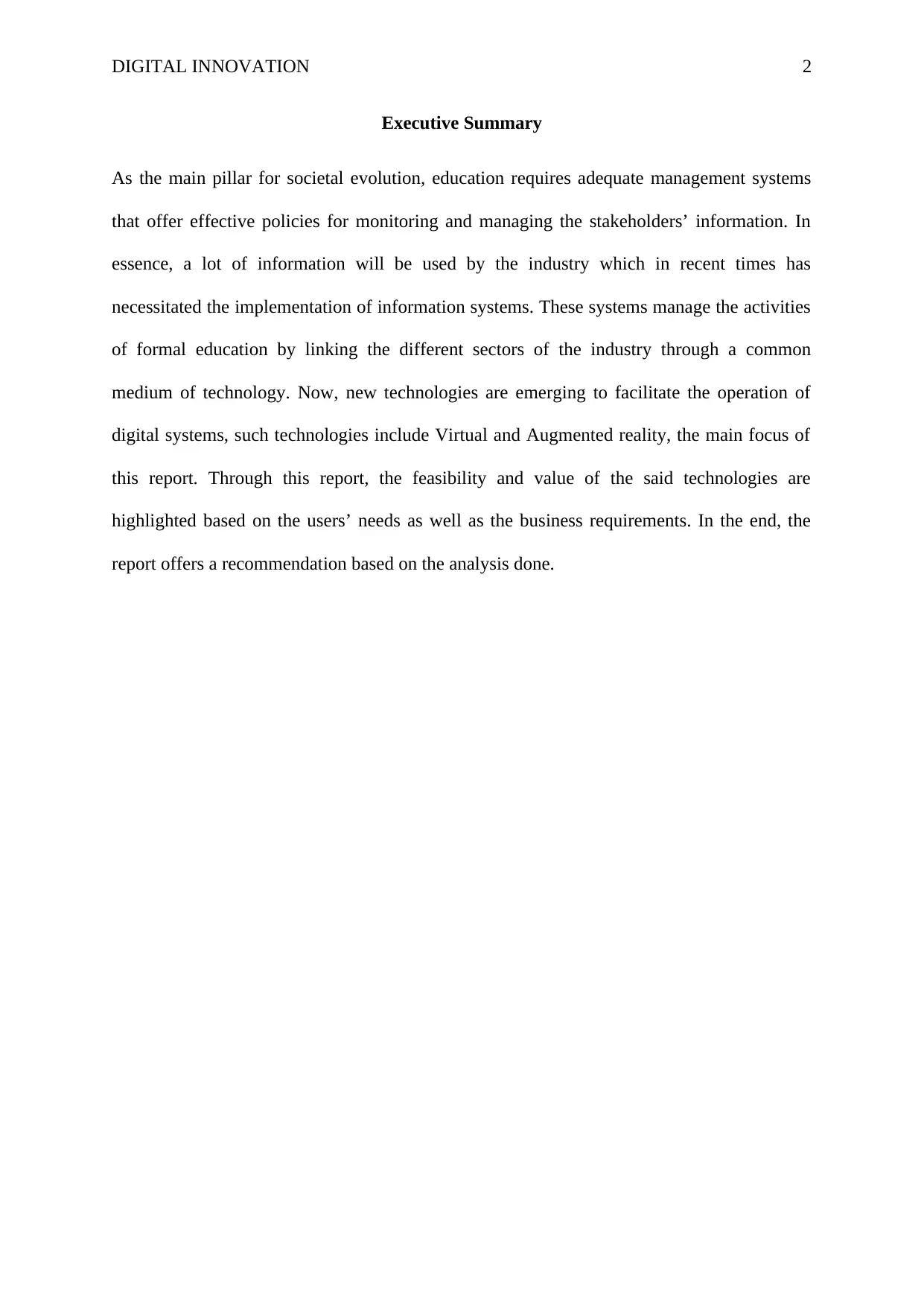
DIGITAL INNOVATION 2
Executive Summary
As the main pillar for societal evolution, education requires adequate management systems
that offer effective policies for monitoring and managing the stakeholders’ information. In
essence, a lot of information will be used by the industry which in recent times has
necessitated the implementation of information systems. These systems manage the activities
of formal education by linking the different sectors of the industry through a common
medium of technology. Now, new technologies are emerging to facilitate the operation of
digital systems, such technologies include Virtual and Augmented reality, the main focus of
this report. Through this report, the feasibility and value of the said technologies are
highlighted based on the users’ needs as well as the business requirements. In the end, the
report offers a recommendation based on the analysis done.
Executive Summary
As the main pillar for societal evolution, education requires adequate management systems
that offer effective policies for monitoring and managing the stakeholders’ information. In
essence, a lot of information will be used by the industry which in recent times has
necessitated the implementation of information systems. These systems manage the activities
of formal education by linking the different sectors of the industry through a common
medium of technology. Now, new technologies are emerging to facilitate the operation of
digital systems, such technologies include Virtual and Augmented reality, the main focus of
this report. Through this report, the feasibility and value of the said technologies are
highlighted based on the users’ needs as well as the business requirements. In the end, the
report offers a recommendation based on the analysis done.
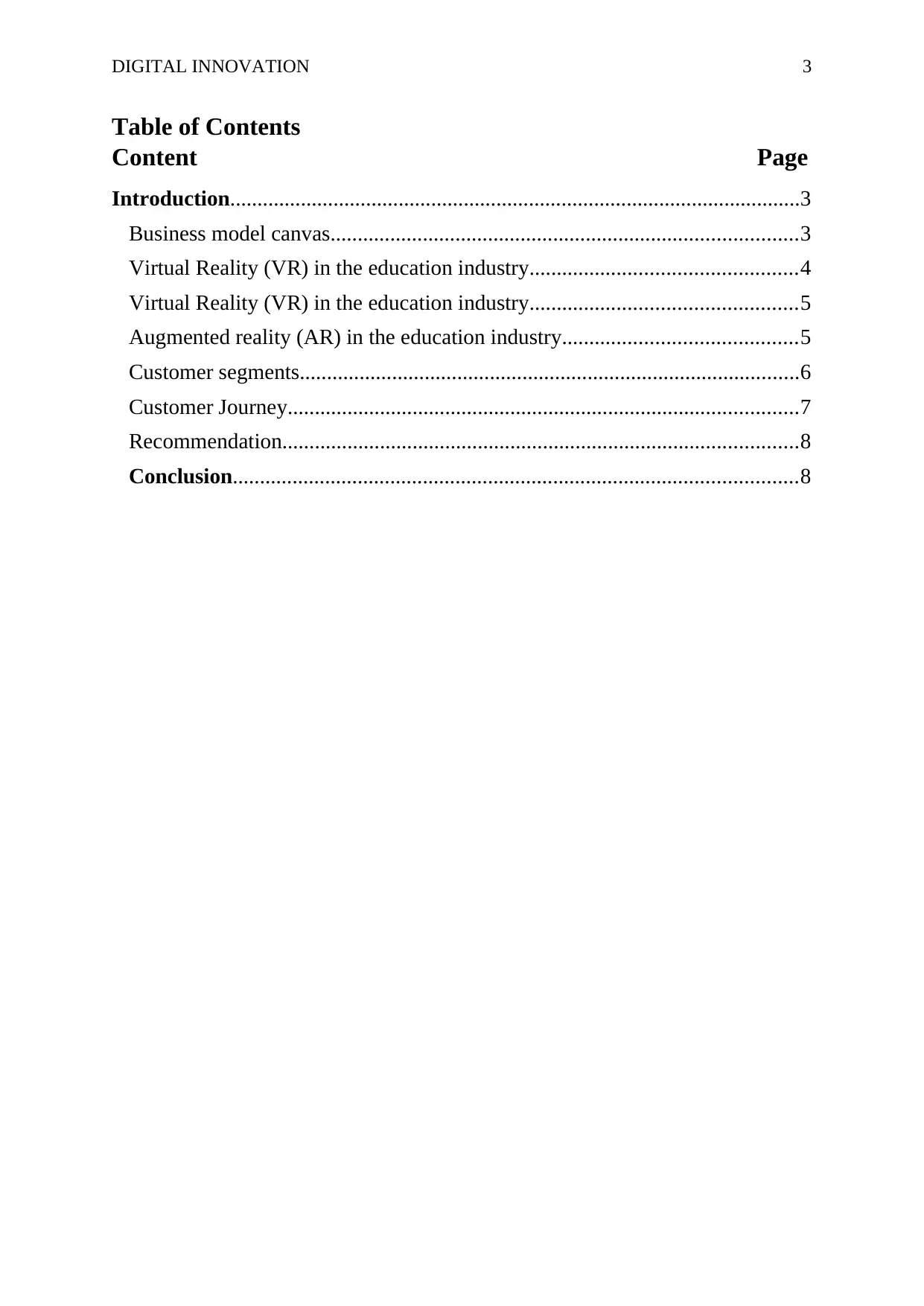
DIGITAL INNOVATION 3
Table of Contents
Content Page
Introduction.........................................................................................................3
Business model canvas......................................................................................3
Virtual Reality (VR) in the education industry.................................................4
Virtual Reality (VR) in the education industry.................................................5
Augmented reality (AR) in the education industry...........................................5
Customer segments............................................................................................6
Customer Journey..............................................................................................7
Recommendation...............................................................................................8
Conclusion........................................................................................................8
Table of Contents
Content Page
Introduction.........................................................................................................3
Business model canvas......................................................................................3
Virtual Reality (VR) in the education industry.................................................4
Virtual Reality (VR) in the education industry.................................................5
Augmented reality (AR) in the education industry...........................................5
Customer segments............................................................................................6
Customer Journey..............................................................................................7
Recommendation...............................................................................................8
Conclusion........................................................................................................8
⊘ This is a preview!⊘
Do you want full access?
Subscribe today to unlock all pages.

Trusted by 1+ million students worldwide
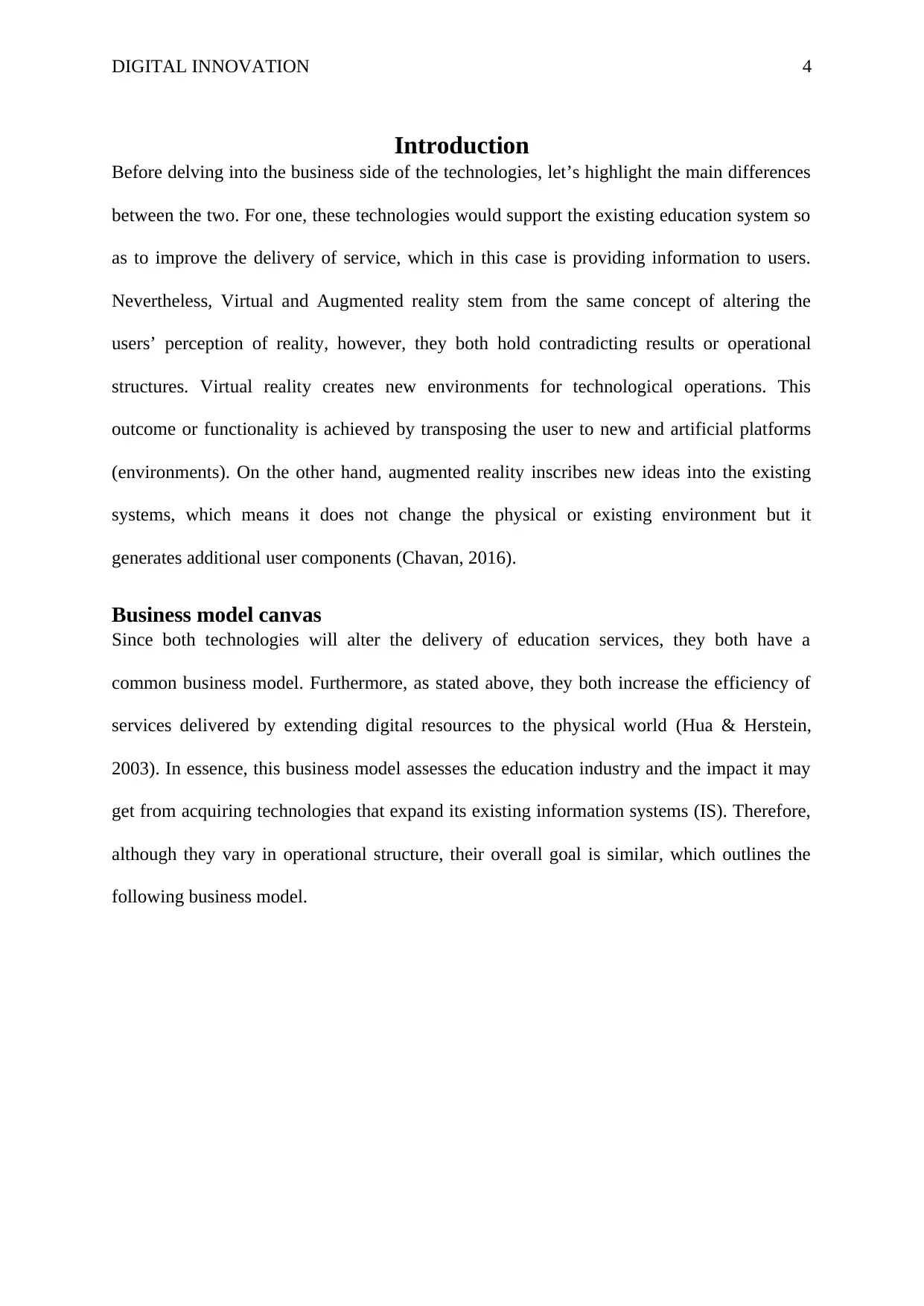
DIGITAL INNOVATION 4
Introduction
Before delving into the business side of the technologies, let’s highlight the main differences
between the two. For one, these technologies would support the existing education system so
as to improve the delivery of service, which in this case is providing information to users.
Nevertheless, Virtual and Augmented reality stem from the same concept of altering the
users’ perception of reality, however, they both hold contradicting results or operational
structures. Virtual reality creates new environments for technological operations. This
outcome or functionality is achieved by transposing the user to new and artificial platforms
(environments). On the other hand, augmented reality inscribes new ideas into the existing
systems, which means it does not change the physical or existing environment but it
generates additional user components (Chavan, 2016).
Business model canvas
Since both technologies will alter the delivery of education services, they both have a
common business model. Furthermore, as stated above, they both increase the efficiency of
services delivered by extending digital resources to the physical world (Hua & Herstein,
2003). In essence, this business model assesses the education industry and the impact it may
get from acquiring technologies that expand its existing information systems (IS). Therefore,
although they vary in operational structure, their overall goal is similar, which outlines the
following business model.
Introduction
Before delving into the business side of the technologies, let’s highlight the main differences
between the two. For one, these technologies would support the existing education system so
as to improve the delivery of service, which in this case is providing information to users.
Nevertheless, Virtual and Augmented reality stem from the same concept of altering the
users’ perception of reality, however, they both hold contradicting results or operational
structures. Virtual reality creates new environments for technological operations. This
outcome or functionality is achieved by transposing the user to new and artificial platforms
(environments). On the other hand, augmented reality inscribes new ideas into the existing
systems, which means it does not change the physical or existing environment but it
generates additional user components (Chavan, 2016).
Business model canvas
Since both technologies will alter the delivery of education services, they both have a
common business model. Furthermore, as stated above, they both increase the efficiency of
services delivered by extending digital resources to the physical world (Hua & Herstein,
2003). In essence, this business model assesses the education industry and the impact it may
get from acquiring technologies that expand its existing information systems (IS). Therefore,
although they vary in operational structure, their overall goal is similar, which outlines the
following business model.
Paraphrase This Document
Need a fresh take? Get an instant paraphrase of this document with our AI Paraphraser
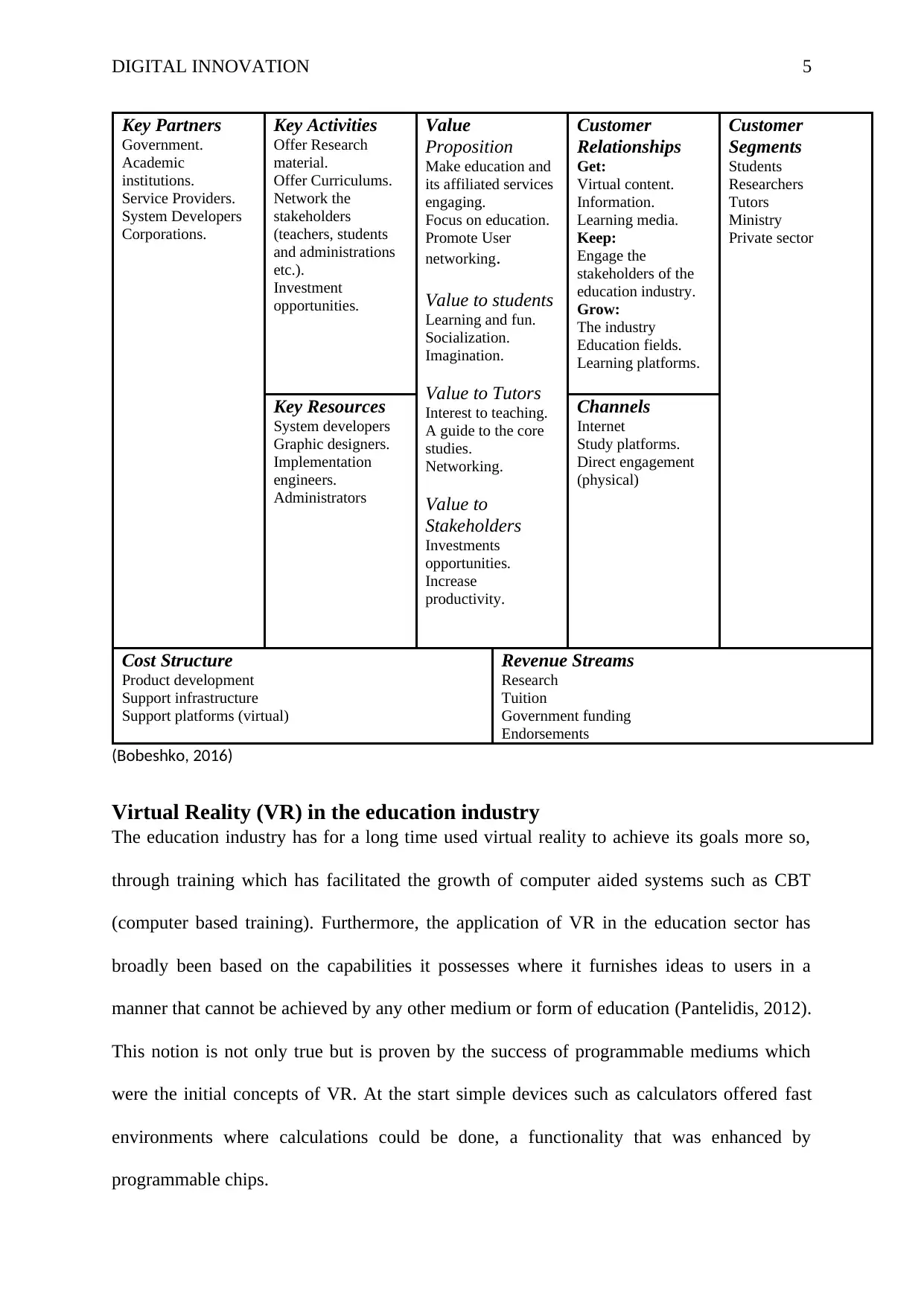
DIGITAL INNOVATION 5
Key Partners
Government.
Academic
institutions.
Service Providers.
System Developers
Corporations.
Key Activities
Offer Research
material.
Offer Curriculums.
Network the
stakeholders
(teachers, students
and administrations
etc.).
Investment
opportunities.
Value
Proposition
Make education and
its affiliated services
engaging.
Focus on education.
Promote User
networking.
Value to students
Learning and fun.
Socialization.
Imagination.
Value to Tutors
Interest to teaching.
A guide to the core
studies.
Networking.
Value to
Stakeholders
Investments
opportunities.
Increase
productivity.
Customer
Relationships
Get:
Virtual content.
Information.
Learning media.
Keep:
Engage the
stakeholders of the
education industry.
Grow:
The industry
Education fields.
Learning platforms.
Customer
Segments
Students
Researchers
Tutors
Ministry
Private sector
Key Resources
System developers
Graphic designers.
Implementation
engineers.
Administrators
Channels
Internet
Study platforms.
Direct engagement
(physical)
Cost Structure
Product development
Support infrastructure
Support platforms (virtual)
Revenue Streams
Research
Tuition
Government funding
Endorsements
(Bobeshko, 2016)
Virtual Reality (VR) in the education industry
The education industry has for a long time used virtual reality to achieve its goals more so,
through training which has facilitated the growth of computer aided systems such as CBT
(computer based training). Furthermore, the application of VR in the education sector has
broadly been based on the capabilities it possesses where it furnishes ideas to users in a
manner that cannot be achieved by any other medium or form of education (Pantelidis, 2012).
This notion is not only true but is proven by the success of programmable mediums which
were the initial concepts of VR. At the start simple devices such as calculators offered fast
environments where calculations could be done, a functionality that was enhanced by
programmable chips.
Key Partners
Government.
Academic
institutions.
Service Providers.
System Developers
Corporations.
Key Activities
Offer Research
material.
Offer Curriculums.
Network the
stakeholders
(teachers, students
and administrations
etc.).
Investment
opportunities.
Value
Proposition
Make education and
its affiliated services
engaging.
Focus on education.
Promote User
networking.
Value to students
Learning and fun.
Socialization.
Imagination.
Value to Tutors
Interest to teaching.
A guide to the core
studies.
Networking.
Value to
Stakeholders
Investments
opportunities.
Increase
productivity.
Customer
Relationships
Get:
Virtual content.
Information.
Learning media.
Keep:
Engage the
stakeholders of the
education industry.
Grow:
The industry
Education fields.
Learning platforms.
Customer
Segments
Students
Researchers
Tutors
Ministry
Private sector
Key Resources
System developers
Graphic designers.
Implementation
engineers.
Administrators
Channels
Internet
Study platforms.
Direct engagement
(physical)
Cost Structure
Product development
Support infrastructure
Support platforms (virtual)
Revenue Streams
Research
Tuition
Government funding
Endorsements
(Bobeshko, 2016)
Virtual Reality (VR) in the education industry
The education industry has for a long time used virtual reality to achieve its goals more so,
through training which has facilitated the growth of computer aided systems such as CBT
(computer based training). Furthermore, the application of VR in the education sector has
broadly been based on the capabilities it possesses where it furnishes ideas to users in a
manner that cannot be achieved by any other medium or form of education (Pantelidis, 2012).
This notion is not only true but is proven by the success of programmable mediums which
were the initial concepts of VR. At the start simple devices such as calculators offered fast
environments where calculations could be done, a functionality that was enhanced by
programmable chips.
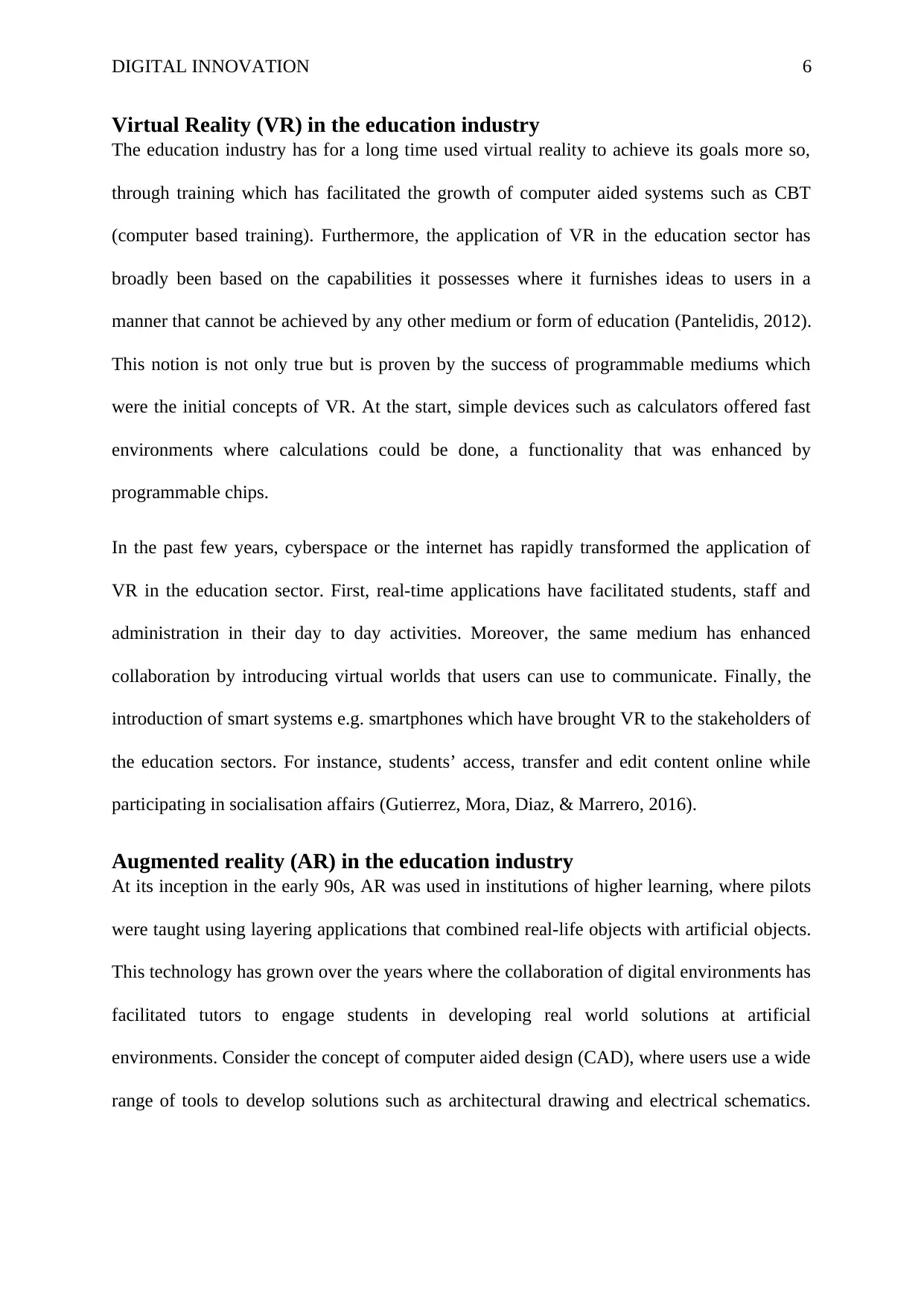
DIGITAL INNOVATION 6
Virtual Reality (VR) in the education industry
The education industry has for a long time used virtual reality to achieve its goals more so,
through training which has facilitated the growth of computer aided systems such as CBT
(computer based training). Furthermore, the application of VR in the education sector has
broadly been based on the capabilities it possesses where it furnishes ideas to users in a
manner that cannot be achieved by any other medium or form of education (Pantelidis, 2012).
This notion is not only true but is proven by the success of programmable mediums which
were the initial concepts of VR. At the start, simple devices such as calculators offered fast
environments where calculations could be done, a functionality that was enhanced by
programmable chips.
In the past few years, cyberspace or the internet has rapidly transformed the application of
VR in the education sector. First, real-time applications have facilitated students, staff and
administration in their day to day activities. Moreover, the same medium has enhanced
collaboration by introducing virtual worlds that users can use to communicate. Finally, the
introduction of smart systems e.g. smartphones which have brought VR to the stakeholders of
the education sectors. For instance, students’ access, transfer and edit content online while
participating in socialisation affairs (Gutierrez, Mora, Diaz, & Marrero, 2016).
Augmented reality (AR) in the education industry
At its inception in the early 90s, AR was used in institutions of higher learning, where pilots
were taught using layering applications that combined real-life objects with artificial objects.
This technology has grown over the years where the collaboration of digital environments has
facilitated tutors to engage students in developing real world solutions at artificial
environments. Consider the concept of computer aided design (CAD), where users use a wide
range of tools to develop solutions such as architectural drawing and electrical schematics.
Virtual Reality (VR) in the education industry
The education industry has for a long time used virtual reality to achieve its goals more so,
through training which has facilitated the growth of computer aided systems such as CBT
(computer based training). Furthermore, the application of VR in the education sector has
broadly been based on the capabilities it possesses where it furnishes ideas to users in a
manner that cannot be achieved by any other medium or form of education (Pantelidis, 2012).
This notion is not only true but is proven by the success of programmable mediums which
were the initial concepts of VR. At the start, simple devices such as calculators offered fast
environments where calculations could be done, a functionality that was enhanced by
programmable chips.
In the past few years, cyberspace or the internet has rapidly transformed the application of
VR in the education sector. First, real-time applications have facilitated students, staff and
administration in their day to day activities. Moreover, the same medium has enhanced
collaboration by introducing virtual worlds that users can use to communicate. Finally, the
introduction of smart systems e.g. smartphones which have brought VR to the stakeholders of
the education sectors. For instance, students’ access, transfer and edit content online while
participating in socialisation affairs (Gutierrez, Mora, Diaz, & Marrero, 2016).
Augmented reality (AR) in the education industry
At its inception in the early 90s, AR was used in institutions of higher learning, where pilots
were taught using layering applications that combined real-life objects with artificial objects.
This technology has grown over the years where the collaboration of digital environments has
facilitated tutors to engage students in developing real world solutions at artificial
environments. Consider the concept of computer aided design (CAD), where users use a wide
range of tools to develop solutions such as architectural drawing and electrical schematics.
⊘ This is a preview!⊘
Do you want full access?
Subscribe today to unlock all pages.

Trusted by 1+ million students worldwide
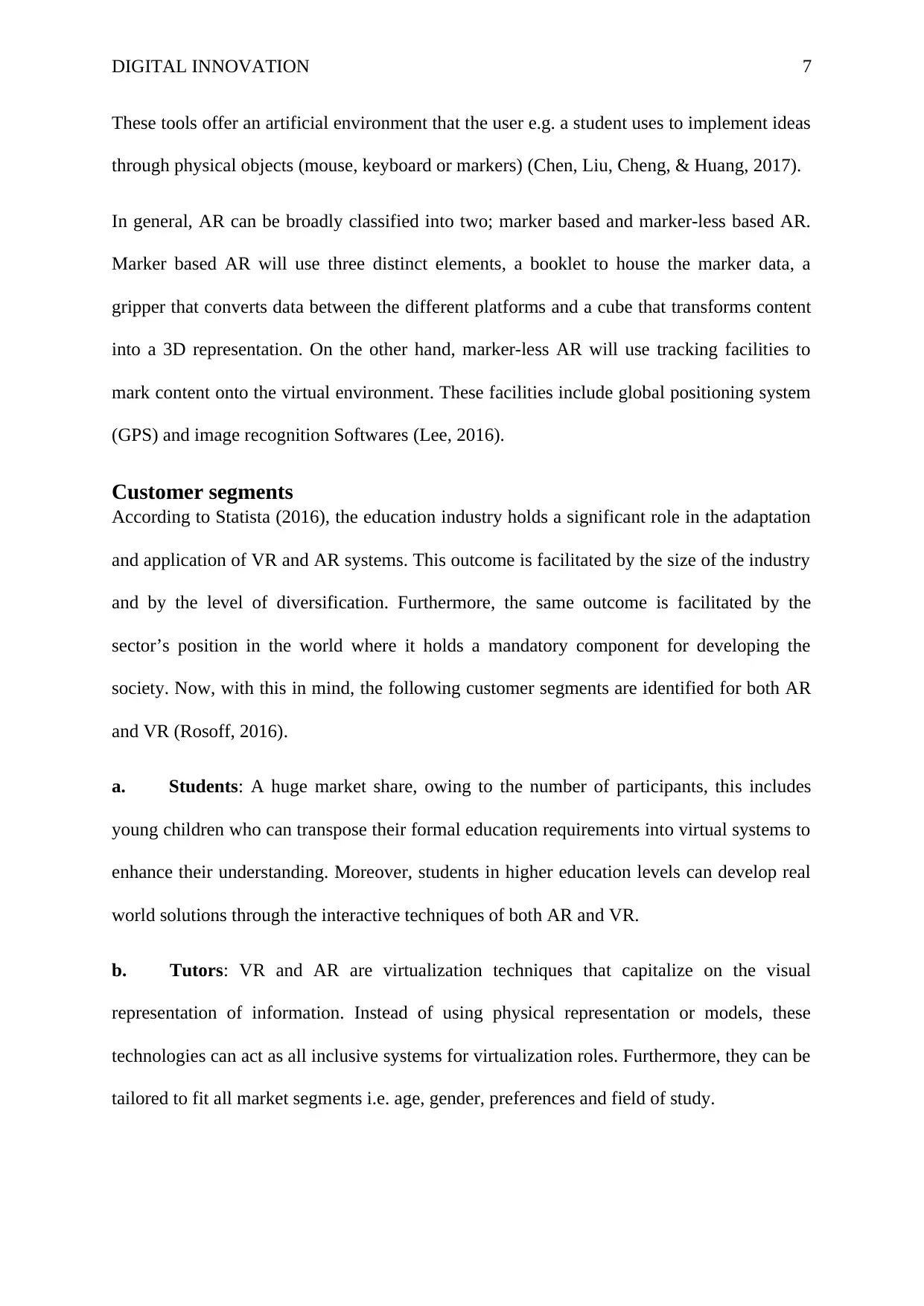
DIGITAL INNOVATION 7
These tools offer an artificial environment that the user e.g. a student uses to implement ideas
through physical objects (mouse, keyboard or markers) (Chen, Liu, Cheng, & Huang, 2017).
In general, AR can be broadly classified into two; marker based and marker-less based AR.
Marker based AR will use three distinct elements, a booklet to house the marker data, a
gripper that converts data between the different platforms and a cube that transforms content
into a 3D representation. On the other hand, marker-less AR will use tracking facilities to
mark content onto the virtual environment. These facilities include global positioning system
(GPS) and image recognition Softwares (Lee, 2016).
Customer segments
According to Statista (2016), the education industry holds a significant role in the adaptation
and application of VR and AR systems. This outcome is facilitated by the size of the industry
and by the level of diversification. Furthermore, the same outcome is facilitated by the
sector’s position in the world where it holds a mandatory component for developing the
society. Now, with this in mind, the following customer segments are identified for both AR
and VR (Rosoff, 2016).
a. Students: A huge market share, owing to the number of participants, this includes
young children who can transpose their formal education requirements into virtual systems to
enhance their understanding. Moreover, students in higher education levels can develop real
world solutions through the interactive techniques of both AR and VR.
b. Tutors: VR and AR are virtualization techniques that capitalize on the visual
representation of information. Instead of using physical representation or models, these
technologies can act as all inclusive systems for virtualization roles. Furthermore, they can be
tailored to fit all market segments i.e. age, gender, preferences and field of study.
These tools offer an artificial environment that the user e.g. a student uses to implement ideas
through physical objects (mouse, keyboard or markers) (Chen, Liu, Cheng, & Huang, 2017).
In general, AR can be broadly classified into two; marker based and marker-less based AR.
Marker based AR will use three distinct elements, a booklet to house the marker data, a
gripper that converts data between the different platforms and a cube that transforms content
into a 3D representation. On the other hand, marker-less AR will use tracking facilities to
mark content onto the virtual environment. These facilities include global positioning system
(GPS) and image recognition Softwares (Lee, 2016).
Customer segments
According to Statista (2016), the education industry holds a significant role in the adaptation
and application of VR and AR systems. This outcome is facilitated by the size of the industry
and by the level of diversification. Furthermore, the same outcome is facilitated by the
sector’s position in the world where it holds a mandatory component for developing the
society. Now, with this in mind, the following customer segments are identified for both AR
and VR (Rosoff, 2016).
a. Students: A huge market share, owing to the number of participants, this includes
young children who can transpose their formal education requirements into virtual systems to
enhance their understanding. Moreover, students in higher education levels can develop real
world solutions through the interactive techniques of both AR and VR.
b. Tutors: VR and AR are virtualization techniques that capitalize on the visual
representation of information. Instead of using physical representation or models, these
technologies can act as all inclusive systems for virtualization roles. Furthermore, they can be
tailored to fit all market segments i.e. age, gender, preferences and field of study.
Paraphrase This Document
Need a fresh take? Get an instant paraphrase of this document with our AI Paraphraser
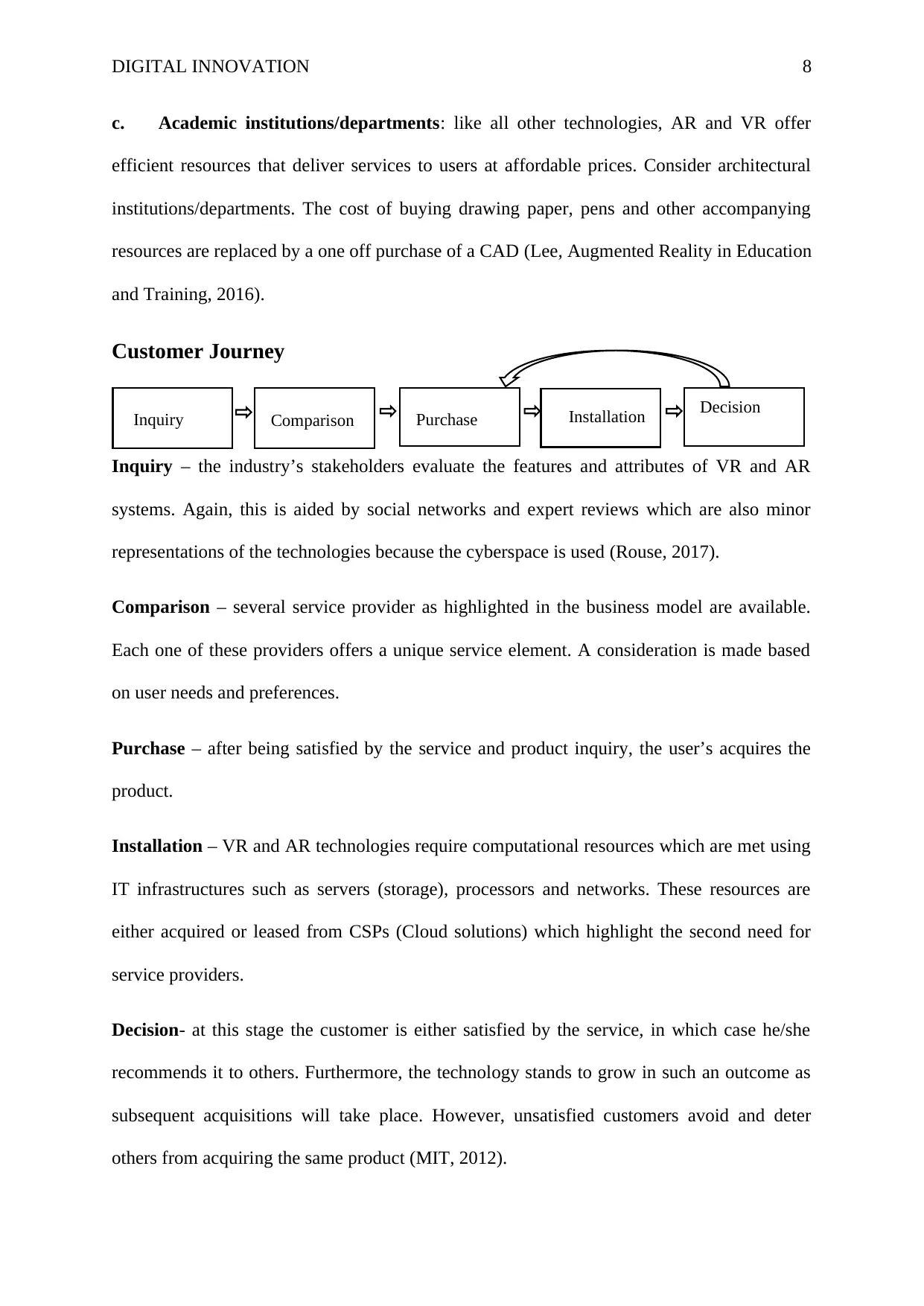
DIGITAL INNOVATION 8
c. Academic institutions/departments: like all other technologies, AR and VR offer
efficient resources that deliver services to users at affordable prices. Consider architectural
institutions/departments. The cost of buying drawing paper, pens and other accompanying
resources are replaced by a one off purchase of a CAD (Lee, Augmented Reality in Education
and Training, 2016).
Customer Journey
Inquiry – the industry’s stakeholders evaluate the features and attributes of VR and AR
systems. Again, this is aided by social networks and expert reviews which are also minor
representations of the technologies because the cyberspace is used (Rouse, 2017).
Comparison – several service provider as highlighted in the business model are available.
Each one of these providers offers a unique service element. A consideration is made based
on user needs and preferences.
Purchase – after being satisfied by the service and product inquiry, the user’s acquires the
product.
Installation – VR and AR technologies require computational resources which are met using
IT infrastructures such as servers (storage), processors and networks. These resources are
either acquired or leased from CSPs (Cloud solutions) which highlight the second need for
service providers.
Decision- at this stage the customer is either satisfied by the service, in which case he/she
recommends it to others. Furthermore, the technology stands to grow in such an outcome as
subsequent acquisitions will take place. However, unsatisfied customers avoid and deter
others from acquiring the same product (MIT, 2012).
Inquiry Comparison Purchase Installation Decision
c. Academic institutions/departments: like all other technologies, AR and VR offer
efficient resources that deliver services to users at affordable prices. Consider architectural
institutions/departments. The cost of buying drawing paper, pens and other accompanying
resources are replaced by a one off purchase of a CAD (Lee, Augmented Reality in Education
and Training, 2016).
Customer Journey
Inquiry – the industry’s stakeholders evaluate the features and attributes of VR and AR
systems. Again, this is aided by social networks and expert reviews which are also minor
representations of the technologies because the cyberspace is used (Rouse, 2017).
Comparison – several service provider as highlighted in the business model are available.
Each one of these providers offers a unique service element. A consideration is made based
on user needs and preferences.
Purchase – after being satisfied by the service and product inquiry, the user’s acquires the
product.
Installation – VR and AR technologies require computational resources which are met using
IT infrastructures such as servers (storage), processors and networks. These resources are
either acquired or leased from CSPs (Cloud solutions) which highlight the second need for
service providers.
Decision- at this stage the customer is either satisfied by the service, in which case he/she
recommends it to others. Furthermore, the technology stands to grow in such an outcome as
subsequent acquisitions will take place. However, unsatisfied customers avoid and deter
others from acquiring the same product (MIT, 2012).
Inquiry Comparison Purchase Installation Decision
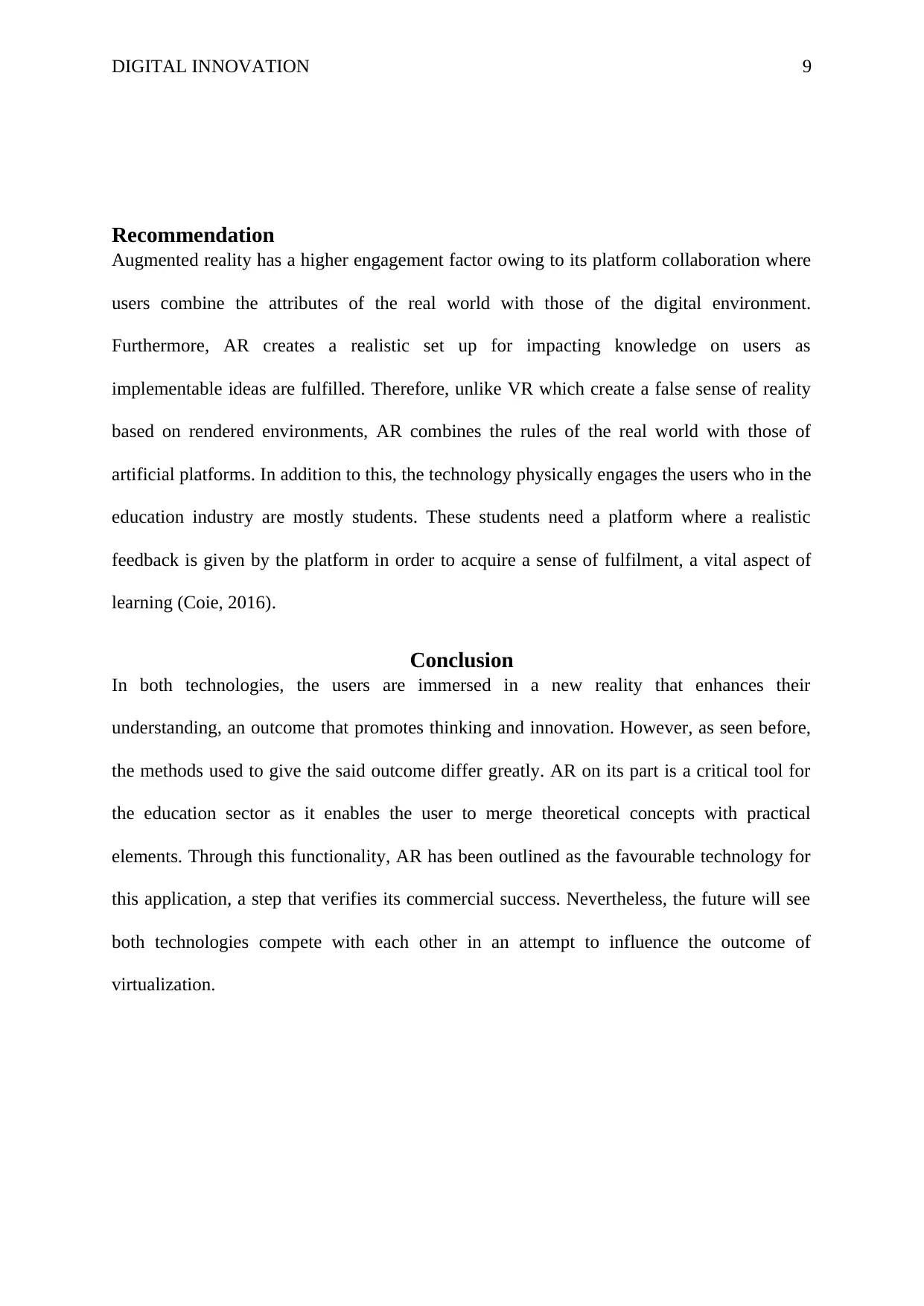
DIGITAL INNOVATION 9
Recommendation
Augmented reality has a higher engagement factor owing to its platform collaboration where
users combine the attributes of the real world with those of the digital environment.
Furthermore, AR creates a realistic set up for impacting knowledge on users as
implementable ideas are fulfilled. Therefore, unlike VR which create a false sense of reality
based on rendered environments, AR combines the rules of the real world with those of
artificial platforms. In addition to this, the technology physically engages the users who in the
education industry are mostly students. These students need a platform where a realistic
feedback is given by the platform in order to acquire a sense of fulfilment, a vital aspect of
learning (Coie, 2016).
Conclusion
In both technologies, the users are immersed in a new reality that enhances their
understanding, an outcome that promotes thinking and innovation. However, as seen before,
the methods used to give the said outcome differ greatly. AR on its part is a critical tool for
the education sector as it enables the user to merge theoretical concepts with practical
elements. Through this functionality, AR has been outlined as the favourable technology for
this application, a step that verifies its commercial success. Nevertheless, the future will see
both technologies compete with each other in an attempt to influence the outcome of
virtualization.
Recommendation
Augmented reality has a higher engagement factor owing to its platform collaboration where
users combine the attributes of the real world with those of the digital environment.
Furthermore, AR creates a realistic set up for impacting knowledge on users as
implementable ideas are fulfilled. Therefore, unlike VR which create a false sense of reality
based on rendered environments, AR combines the rules of the real world with those of
artificial platforms. In addition to this, the technology physically engages the users who in the
education industry are mostly students. These students need a platform where a realistic
feedback is given by the platform in order to acquire a sense of fulfilment, a vital aspect of
learning (Coie, 2016).
Conclusion
In both technologies, the users are immersed in a new reality that enhances their
understanding, an outcome that promotes thinking and innovation. However, as seen before,
the methods used to give the said outcome differ greatly. AR on its part is a critical tool for
the education sector as it enables the user to merge theoretical concepts with practical
elements. Through this functionality, AR has been outlined as the favourable technology for
this application, a step that verifies its commercial success. Nevertheless, the future will see
both technologies compete with each other in an attempt to influence the outcome of
virtualization.
⊘ This is a preview!⊘
Do you want full access?
Subscribe today to unlock all pages.

Trusted by 1+ million students worldwide
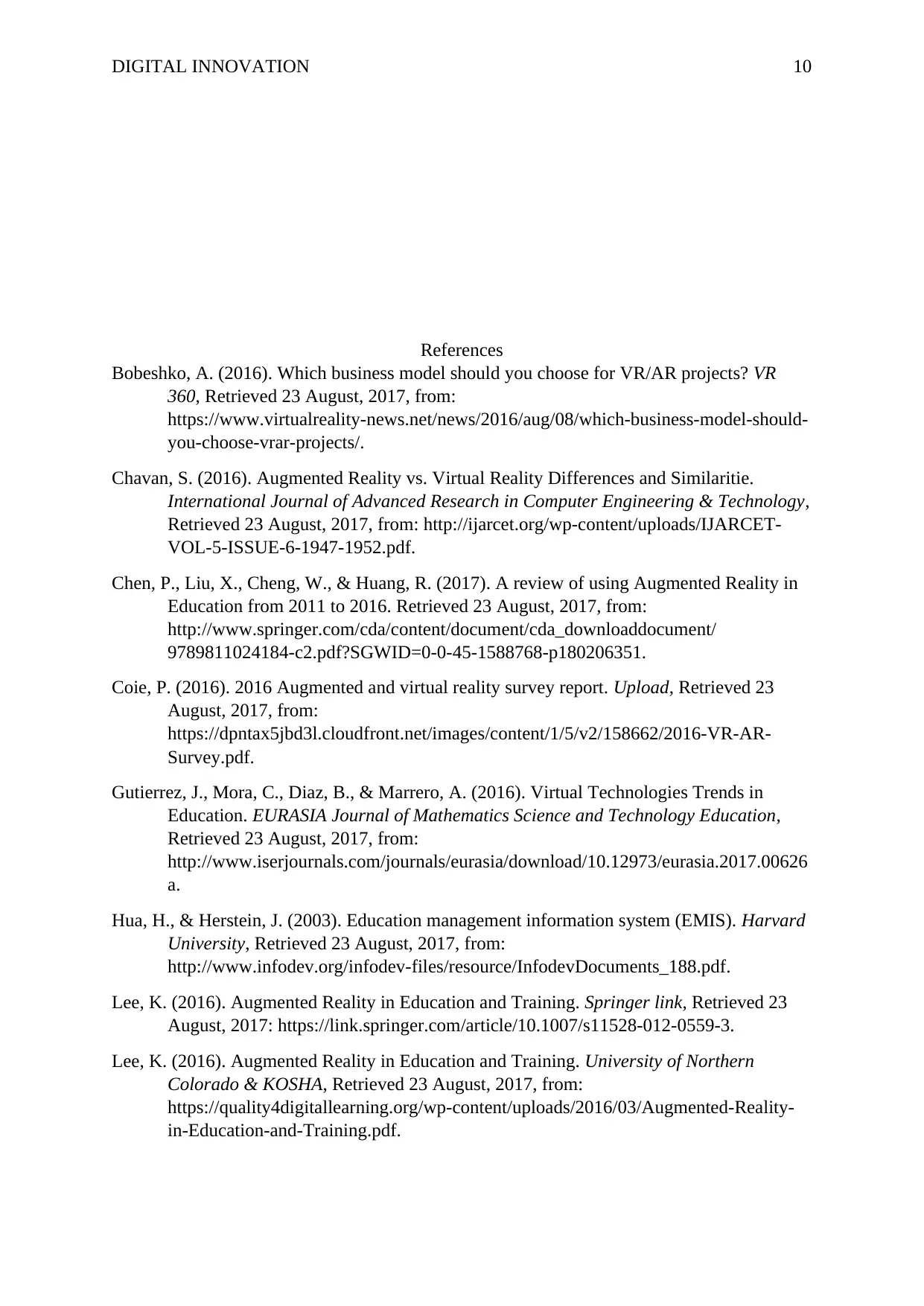
DIGITAL INNOVATION 10
References
Bobeshko, A. (2016). Which business model should you choose for VR/AR projects? VR
360, Retrieved 23 August, 2017, from:
https://www.virtualreality-news.net/news/2016/aug/08/which-business-model-should-
you-choose-vrar-projects/.
Chavan, S. (2016). Augmented Reality vs. Virtual Reality Differences and Similaritie.
International Journal of Advanced Research in Computer Engineering & Technology,
Retrieved 23 August, 2017, from: http://ijarcet.org/wp-content/uploads/IJARCET-
VOL-5-ISSUE-6-1947-1952.pdf.
Chen, P., Liu, X., Cheng, W., & Huang, R. (2017). A review of using Augmented Reality in
Education from 2011 to 2016. Retrieved 23 August, 2017, from:
http://www.springer.com/cda/content/document/cda_downloaddocument/
9789811024184-c2.pdf?SGWID=0-0-45-1588768-p180206351.
Coie, P. (2016). 2016 Augmented and virtual reality survey report. Upload, Retrieved 23
August, 2017, from:
https://dpntax5jbd3l.cloudfront.net/images/content/1/5/v2/158662/2016-VR-AR-
Survey.pdf.
Gutierrez, J., Mora, C., Diaz, B., & Marrero, A. (2016). Virtual Technologies Trends in
Education. EURASIA Journal of Mathematics Science and Technology Education,
Retrieved 23 August, 2017, from:
http://www.iserjournals.com/journals/eurasia/download/10.12973/eurasia.2017.00626
a.
Hua, H., & Herstein, J. (2003). Education management information system (EMIS). Harvard
University, Retrieved 23 August, 2017, from:
http://www.infodev.org/infodev-files/resource/InfodevDocuments_188.pdf.
Lee, K. (2016). Augmented Reality in Education and Training. Springer link, Retrieved 23
August, 2017: https://link.springer.com/article/10.1007/s11528-012-0559-3.
Lee, K. (2016). Augmented Reality in Education and Training. University of Northern
Colorado & KOSHA, Retrieved 23 August, 2017, from:
https://quality4digitallearning.org/wp-content/uploads/2016/03/Augmented-Reality-
in-Education-and-Training.pdf.
References
Bobeshko, A. (2016). Which business model should you choose for VR/AR projects? VR
360, Retrieved 23 August, 2017, from:
https://www.virtualreality-news.net/news/2016/aug/08/which-business-model-should-
you-choose-vrar-projects/.
Chavan, S. (2016). Augmented Reality vs. Virtual Reality Differences and Similaritie.
International Journal of Advanced Research in Computer Engineering & Technology,
Retrieved 23 August, 2017, from: http://ijarcet.org/wp-content/uploads/IJARCET-
VOL-5-ISSUE-6-1947-1952.pdf.
Chen, P., Liu, X., Cheng, W., & Huang, R. (2017). A review of using Augmented Reality in
Education from 2011 to 2016. Retrieved 23 August, 2017, from:
http://www.springer.com/cda/content/document/cda_downloaddocument/
9789811024184-c2.pdf?SGWID=0-0-45-1588768-p180206351.
Coie, P. (2016). 2016 Augmented and virtual reality survey report. Upload, Retrieved 23
August, 2017, from:
https://dpntax5jbd3l.cloudfront.net/images/content/1/5/v2/158662/2016-VR-AR-
Survey.pdf.
Gutierrez, J., Mora, C., Diaz, B., & Marrero, A. (2016). Virtual Technologies Trends in
Education. EURASIA Journal of Mathematics Science and Technology Education,
Retrieved 23 August, 2017, from:
http://www.iserjournals.com/journals/eurasia/download/10.12973/eurasia.2017.00626
a.
Hua, H., & Herstein, J. (2003). Education management information system (EMIS). Harvard
University, Retrieved 23 August, 2017, from:
http://www.infodev.org/infodev-files/resource/InfodevDocuments_188.pdf.
Lee, K. (2016). Augmented Reality in Education and Training. Springer link, Retrieved 23
August, 2017: https://link.springer.com/article/10.1007/s11528-012-0559-3.
Lee, K. (2016). Augmented Reality in Education and Training. University of Northern
Colorado & KOSHA, Retrieved 23 August, 2017, from:
https://quality4digitallearning.org/wp-content/uploads/2016/03/Augmented-Reality-
in-Education-and-Training.pdf.
Paraphrase This Document
Need a fresh take? Get an instant paraphrase of this document with our AI Paraphraser
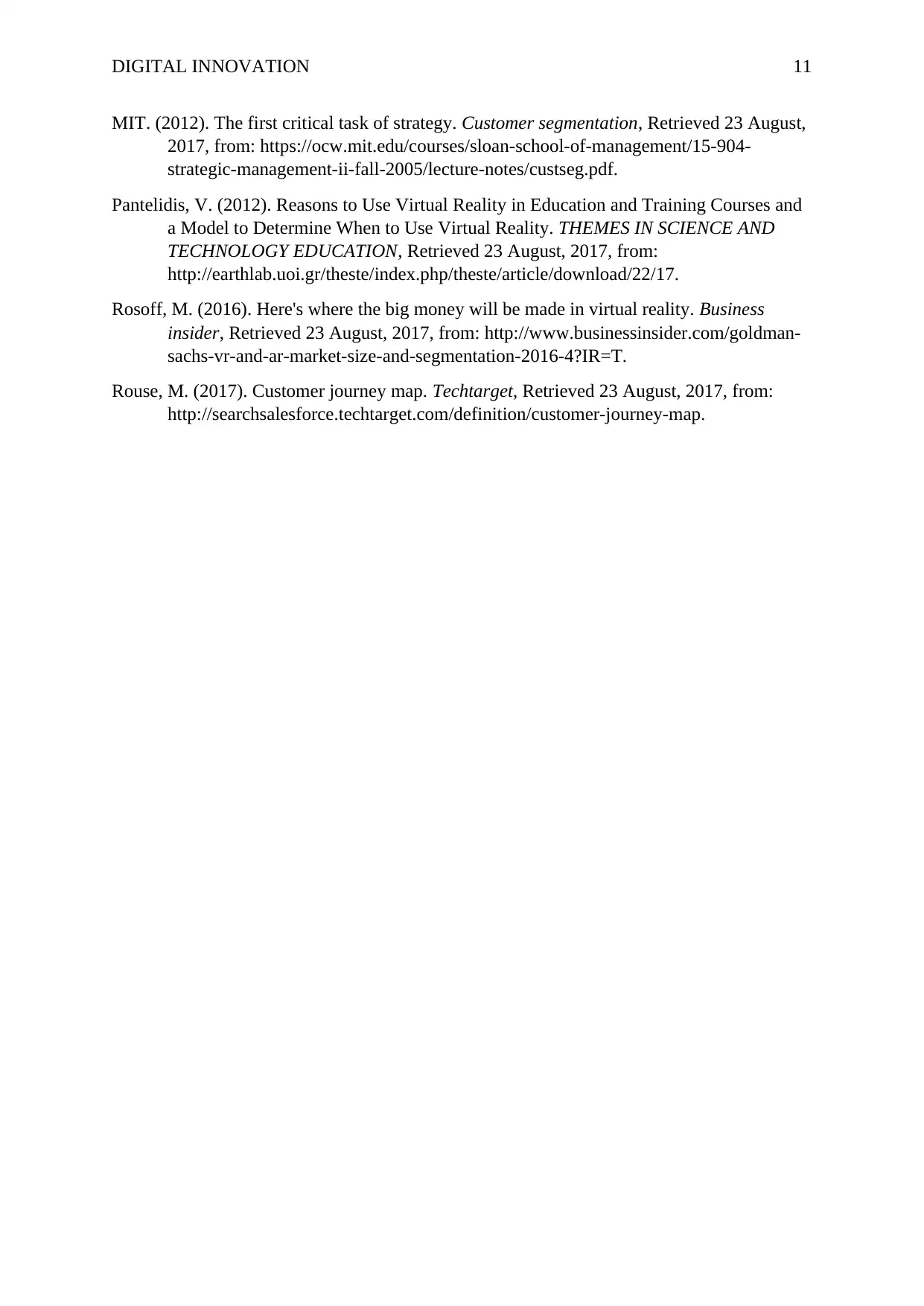
DIGITAL INNOVATION 11
MIT. (2012). The first critical task of strategy. Customer segmentation, Retrieved 23 August,
2017, from: https://ocw.mit.edu/courses/sloan-school-of-management/15-904-
strategic-management-ii-fall-2005/lecture-notes/custseg.pdf.
Pantelidis, V. (2012). Reasons to Use Virtual Reality in Education and Training Courses and
a Model to Determine When to Use Virtual Reality. THEMES IN SCIENCE AND
TECHNOLOGY EDUCATION, Retrieved 23 August, 2017, from:
http://earthlab.uoi.gr/theste/index.php/theste/article/download/22/17.
Rosoff, M. (2016). Here's where the big money will be made in virtual reality. Business
insider, Retrieved 23 August, 2017, from: http://www.businessinsider.com/goldman-
sachs-vr-and-ar-market-size-and-segmentation-2016-4?IR=T.
Rouse, M. (2017). Customer journey map. Techtarget, Retrieved 23 August, 2017, from:
http://searchsalesforce.techtarget.com/definition/customer-journey-map.
MIT. (2012). The first critical task of strategy. Customer segmentation, Retrieved 23 August,
2017, from: https://ocw.mit.edu/courses/sloan-school-of-management/15-904-
strategic-management-ii-fall-2005/lecture-notes/custseg.pdf.
Pantelidis, V. (2012). Reasons to Use Virtual Reality in Education and Training Courses and
a Model to Determine When to Use Virtual Reality. THEMES IN SCIENCE AND
TECHNOLOGY EDUCATION, Retrieved 23 August, 2017, from:
http://earthlab.uoi.gr/theste/index.php/theste/article/download/22/17.
Rosoff, M. (2016). Here's where the big money will be made in virtual reality. Business
insider, Retrieved 23 August, 2017, from: http://www.businessinsider.com/goldman-
sachs-vr-and-ar-market-size-and-segmentation-2016-4?IR=T.
Rouse, M. (2017). Customer journey map. Techtarget, Retrieved 23 August, 2017, from:
http://searchsalesforce.techtarget.com/definition/customer-journey-map.
1 out of 11
Related Documents
Your All-in-One AI-Powered Toolkit for Academic Success.
+13062052269
info@desklib.com
Available 24*7 on WhatsApp / Email
![[object Object]](/_next/static/media/star-bottom.7253800d.svg)
Unlock your academic potential
Copyright © 2020–2025 A2Z Services. All Rights Reserved. Developed and managed by ZUCOL.





